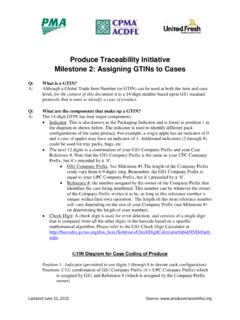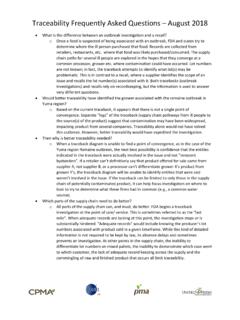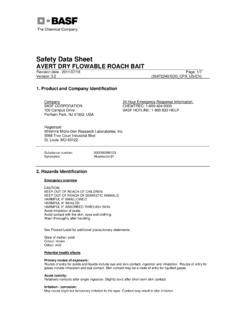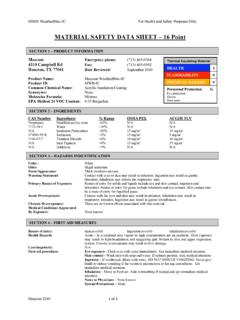Transcription of Produce Traceability Initiative Why and How to …
1 Produce Traceability Initiative Why and How to Use EDI 856 Advance Ship Notice 1 Released: October 5, 2012 Source: Produce Traceability Initiative Why and How to Use EDI 856 Advance Ship Notice/Manifest Transaction Set (ASN) (Revision ) About this Guidance Document Guidelines are generally accepted, informally standardized techniques, methods or processes that have proven themselves over time to accomplish given tasks. The idea is that with proper processes, checks and testing, a desired outcome can be delivered more effectively with fewer problems and unforeseen complications.
2 In addition, a guideline can evolve to become better as improvements are discovered. The Produce Traceability Initiative (PTI) is a voluntary Produce Initiative . The guidelines are the recommendations created and agreed to by all facets of the Produce industry supply chain and PTI Leadership Council. Consent between trading partners may replace specific recommendations as long as the minimum Traceability information requirements are met in good faith. Revision History This section itemizes the changes from the last published Guidance Document. Version No. Date of Change Changed By Summary of Change October 2012 Master Data Working Group and Technology Working Group Original document Produce Traceability Initiative Why and How to Use EDI 856 Advance Ship Notice 2 Released: October 5, 2012 Source: Objectives The objectives for this guidance document developed by industry participants of the Produce Traceability Initiative (PTI) are to: explain what an Electronic Data Interchange (EDI) Advance Ship Notice (ASN) is and why companies may choose to implement.
3 Outline business benefits derived from the use of an ASN; detail how the ASN can be used to facilitate capturing the Global Trade Item Number or GTIN and corresponding Batch/Lot Numbers with only one pallet barcode; and provide specifications for how to implement an EDI 856 Advance Ship Notice for Produce shipments. Table 1: Terms/Definitions Listed below are terms used by the Produce industry and their cross-references with the GS1 Glossary of Terms: Sector Term GS1 Glossary Term Definition Advance Ship Notice/Manifest (ASN) An Electronic Data Interchange (EDI) transaction that provides the receiving company with advance data on shipments to better plan workloads and receipt processing.
4 In the implementation of the transaction, the latest the ship notice may be sent is the time of shipment. In practice, the ship notice must arrive before the shipment. Bill of Lading A legal document between the shipper of a particular good and the carrier detailing the type, quantity and destination of the good being carried. The bill of lading also serves as a receipt of shipment when the good is delivered to the predetermined destination. This document must accompany the shipped goods, no matter the form of transportation, and must be signed by an authorized representative from the carrier, shipper and receiver.
5 Brand Owner The one who owns or has legal rights to the Label/Brand. Buyer (See Trading Partner) This term is used to refer to the trading partner who issues an order to the supplier. This party can be a retailer, a distributor, or a re-distributor. Electronic Data Interchange (EDI) A standard format for computer-to-computer transmission of business information and transactions between trading partners, such as invoices and purchase orders. Produce Traceability Initiative Why and How to Use EDI 856 Advance Ship Notice 3 Released: October 5, 2012 Source: Sector Term GS1 Glossary Term Definition Global Trade Item Number (GTIN ) The globally unique GS1 System identification number for products and services.
6 A GTIN may be 8, 12, 13, or 14 digits in length. The GTIN-14 has been selected for use in the PTI. Label/Brand (See Brand Owner) The name or trademark connected with a product or marketer. Private label/brand (See Brand Owner) These products typically are manufactured, packed or provided by one or more companies for offer under a brand, which is owned, by a company other than the manufacturing or producing company. Serial Shipping Container Code (SSCC-18) Term used for the Serial Shipping Container Code. The unique identification of a logistic unit using an 18-digit data structure Supplier (See Trading Partner) The trading partner who receives an order from a buyer and ships it.
7 This party can be a grower, a distributor, or a re-distributor. Trading Partner A party to transactions in the supply chain, such as a supplier (seller) or a customer (buyer). What is an ASN? The EDI Advance Ship Notice/Manifest or ASN provides order and shipment information in one electronic transaction sent from the shipper to the receiver. While the ASN is similar to a Bill of Lading (BOL) and even carries much of the same information, it has a much different function. The BOL is meant to accompany a shipment along its path. An ASN is intended to provide its information in advance of the actual shipment arriving at its destination.
8 The value of the ASN comes from receiving it prior to the actual shipment. This tends to impact the logistics stream in three areas: cost, accuracy, and flexibility. Cost - Today s receiving systems are designed as fast moving environments where there is little time to open and breakdown cases for manual receipt or verification of contents against paperwork. Instead, these systems depend on the scanning of barcodes from shipping labels. ASNs, which include Serial Shipping Container Codes (SSCC), provide the contents of each pallet, including the GTIN, corresponding Batch/Lot Numbers, and the quantity of each GTIN and Batch/Lot Number combination on the pallet.
9 This greatly increases the speed of the receiving process as what is captured from reading the SSCC from each pallet can be matched to the information previously sent in the ASN. The ASN also provides quantities and contents that allow for the receipt and put away of the goods. Receiving costs are thought to be reduced by about 40% when using ASNs. Produce Traceability Initiative Why and How to Use EDI 856 Advance Ship Notice 4 Released: October 5, 2012 Source: Accuracy - Upon receipt of the ASN, the receiver is immediately informed of any difference between what was ordered, and what was actually shipped.
10 (including substitutions) Flexibility - Knowing the actual fill rates ahead of receiving the orders gives the recipient the opportunity to re-allocate goods in subsequent outbound shipments. Benefits of implementation of the ASN The following are potential benefits from the use of ASNs: Eliminates the need for paper-based communications Enables automatic capture of the GTIN and Batch/Lot Numbers of each case Ensures accuracy between product shipped and product received Reduces off-loading time at receiving dock Reduces check-in time from receipt to selling floor Facilitates the cross docking process Allows for advance order allocation Facilitates mechanized receiving Allows for integration of data to multiple systems without multiple data entry Allows for resource scheduling by the receiver Promotes the ability to plan space









